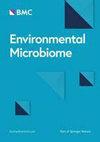可解释的机器学习解码土壤微生物组对干旱胁迫的反应
IF 6.2
2区 环境科学与生态学
Q1 GENETICS & HEREDITY
引用次数: 0
摘要
气候变化引发的极端天气事件,尤其是干旱,对作物产量和粮食安全造成了不利影响。同时,这些情况也会引起土壤细菌微生物群发生重大变化,影响植物健康。及早识别受干旱影响的土壤可帮助农民实施适当的农业管理措施。在这种情况下,基于标记类群的可解释机器学习在土壤干旱胁迫分类方面具有巨大潜力。本研究表明,基于 16S rRNA 的元基因组差异丰度分析方法和基于机器学习的 Shapley Additive Explanation 值提供了相似的信息。这两种方法具有互补潜力,可用于识别标记类群并研究干旱胁迫下禾本科植物类群的富集或耗竭情况。此外,对来自不同植物物种土壤细菌微生物群的各种相对丰度数据进行训练的随机森林分类器,在干旱胁迫预测中的属级准确率高达 92.3%。这证明了它对所测试菌系的概括能力。在土壤细菌微生物群的干旱胁迫检测中,本研究强调了基于位置的优化和泛化 ML 分类器的潜力。通过识别标记类群,这种方法对微生物辅助植物育种计划具有重要意义,并有助于可持续农业实践的发展。面对气候变化,这些发现对于维护全球粮食安全至关重要。本文章由计算机程序翻译,如有差异,请以英文原文为准。
Interpretable machine learning decodes soil microbiome’s response to drought stress
Extreme weather events induced by climate change, particularly droughts, have detrimental consequences for crop yields and food security. Concurrently, these conditions provoke substantial changes in the soil bacterial microbiota and affect plant health. Early recognition of soil affected by drought enables farmers to implement appropriate agricultural management practices. In this context, interpretable machine learning holds immense potential for drought stress classification of soil based on marker taxa. This study demonstrates that the 16S rRNA-based metagenomic approach of Differential Abundance Analysis methods and machine learning-based Shapley Additive Explanation values provide similar information. They exhibit their potential as complementary approaches for identifying marker taxa and investigating their enrichment or depletion under drought stress in grass lineages. Additionally, the Random Forest Classifier trained on a diverse range of relative abundance data from the soil bacterial micobiome of various plant species achieves a high accuracy of 92.3 % at the genus rank for drought stress prediction. It demonstrates its generalization capacity for the lineages tested. In the detection of drought stress in soil bacterial microbiota, this study emphasizes the potential of an optimized and generalized location-based ML classifier. By identifying marker taxa, this approach holds promising implications for microbe-assisted plant breeding programs and contributes to the development of sustainable agriculture practices. These findings are crucial for preserving global food security in the face of climate change.
求助全文
通过发布文献求助,成功后即可免费获取论文全文。
去求助
来源期刊

Environmental Microbiome
Immunology and Microbiology-Microbiology
CiteScore
7.40
自引率
2.50%
发文量
55
审稿时长
13 weeks
期刊介绍:
Microorganisms, omnipresent across Earth's diverse environments, play a crucial role in adapting to external changes, influencing Earth's systems and cycles, and contributing significantly to agricultural practices. Through applied microbiology, they offer solutions to various everyday needs. Environmental Microbiome recognizes the universal presence and significance of microorganisms, inviting submissions that explore the diverse facets of environmental and applied microbiological research.
 求助内容:
求助内容: 应助结果提醒方式:
应助结果提醒方式:


